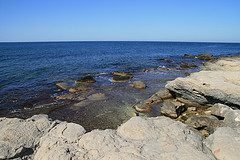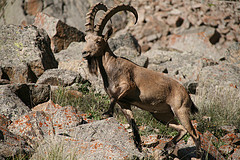The pilgrimage to Beket-Ata
Tuesday, September 15th, 2009The main reason we travelled across the length of Kazakhstan to begin with was to join Muslim pilgrims in their journey to the tomb of Beket-Ata in the desert near Aktau. Thankfully, given the time and effort expended, it was quite extraordinary – not only the highlight of our three weeks in Kazakhstan, but one of the most spiritual experiences of my life.
At dawn opposite the bazaar in Zhanaozen, two hours from Aktau, a handful of jeeps and 4WD ‘tank’ minibuses were waiting for pilgrims wanting to make the journey through the desert to Beket-Ata. We joined a local family of seven – four men and three women, including an old lady who had only one eye and could not walk without support – in a minibus, and by eight o’clock we were on the road. Leaving Zhanaozen we passed hundreds of oil drills right along the highway, more than I’ve ever seen, even having lived in the Arabian Gulf. (And I should point out here that in their own strange way, Aktau and Zhanaozen somewhat resembled the Gulf in their town planning and architecture, though still with an unmistakable Soviet feel as well in some parts.) Soon the sealed road was no more, and we drove through the desert that was, thankfully, more interesting than any we had previously seen in Kazakhstan. Here there were rock formations and plateaus in a mix of whites and pinks and everything in between, and none of the flat shrubbery that had completely dominated the landscape ever since Almaty.
 Soon we reached our first stop at Shopan-Ata. We performed ablutions with the other pilgrims and were treated to the first of our five meals of the day (all provided free of charge): a surprisingly good spread of breads, meats, fruits, vegetables and sweets, much tastier and more varied than we had expected. (And as a side note: even these Muslim pilgrims were not fasting during Ramadan.) We walked through a nearby necropolis en route to the main attraction: the tomb of Shopan-Ata, contained within an ‘underground mosque’, which could perhaps more accurately be described as a cave mosque. You enter through a small door into a surprisingly homely cave-like room with carpets covering the floors and a hole in the ceiling offering light in the style of the Roman Pantheon. There we sat with the pilgrims as they prayed and performed certain rituals which seem to derive from ancient regional beliefs rather than orthodox Islam, including whispering (praying?) to a tree branch in the middle of the room and then circling it three times. We then saw the tomb of Shopan-Ata himself in an adjacent room, for which even I needed to cover my head; the mosque’s imam gave me a Muslim mosque cap for the purpose, and when I tried to return it later he wouldn’t let me. I was very thankful for the gesture and I will keep it forever as a memento that has so much more meaning than if I had bought the exact same cap at a tourist stall (and, for what it’s worth, I do like these caps anyway and have considered buying one in the past in places like Oman). It was this generosity and willingness to include us, as clearly the only tourists there that day among over 100 pilgrims, in all activities (washing, eating, praying, sleeping) that made the whole journey so special.
Soon we reached our first stop at Shopan-Ata. We performed ablutions with the other pilgrims and were treated to the first of our five meals of the day (all provided free of charge): a surprisingly good spread of breads, meats, fruits, vegetables and sweets, much tastier and more varied than we had expected. (And as a side note: even these Muslim pilgrims were not fasting during Ramadan.) We walked through a nearby necropolis en route to the main attraction: the tomb of Shopan-Ata, contained within an ‘underground mosque’, which could perhaps more accurately be described as a cave mosque. You enter through a small door into a surprisingly homely cave-like room with carpets covering the floors and a hole in the ceiling offering light in the style of the Roman Pantheon. There we sat with the pilgrims as they prayed and performed certain rituals which seem to derive from ancient regional beliefs rather than orthodox Islam, including whispering (praying?) to a tree branch in the middle of the room and then circling it three times. We then saw the tomb of Shopan-Ata himself in an adjacent room, for which even I needed to cover my head; the mosque’s imam gave me a Muslim mosque cap for the purpose, and when I tried to return it later he wouldn’t let me. I was very thankful for the gesture and I will keep it forever as a memento that has so much more meaning than if I had bought the exact same cap at a tourist stall (and, for what it’s worth, I do like these caps anyway and have considered buying one in the past in places like Oman). It was this generosity and willingness to include us, as clearly the only tourists there that day among over 100 pilgrims, in all activities (washing, eating, praying, sleeping) that made the whole journey so special.
 After returning from the mosque we were treated to another meal, and this time men and women sat in separate circles to eat the Kazakh national dish – beshbarmak – which, as essentially a huge chunk of all-inclusive goat meat on top of a noodle or rice base, was more typically Muslim than the rituals of the mosque. We ate communally with our hands, allowing me to choose the more appealing pieces of meat and leaving the fat and innards for the Kazakhs to gobble up. But when our group was given a goat skull as, I suppose, a kind of dessert treat (since not all groups got one), and after one of my company spent much effort cutting it up to get to the brain, and then offered me some, I had nowhere to hide. It was quite mushy, but not too bad.
After returning from the mosque we were treated to another meal, and this time men and women sat in separate circles to eat the Kazakh national dish – beshbarmak – which, as essentially a huge chunk of all-inclusive goat meat on top of a noodle or rice base, was more typically Muslim than the rituals of the mosque. We ate communally with our hands, allowing me to choose the more appealing pieces of meat and leaving the fat and innards for the Kazakhs to gobble up. But when our group was given a goat skull as, I suppose, a kind of dessert treat (since not all groups got one), and after one of my company spent much effort cutting it up to get to the brain, and then offered me some, I had nowhere to hide. It was quite mushy, but not too bad.
After leaving Shopan-Ata we continued for another two hours or so to Beket-Ata, where all the pilgrims would spend the night. Not many foreigners make this trip, so we were the talk of the group; I discovered that Kazakhs, on the whole, are quite familiar with kangaroos. We were befriended by a woman from Aktau named Baktagul who spoke English reasonably well and was staying indefinitely at Beket-Ata to pray for her son, whom she described as having a ‘psychological illness’ that could only be cured by spirits and not by a medical doctor. She told us stories about Beket-Ata (she said she knew enough to fill a book), and was delighted when we saw eight goats on our way to and from the tomb, as the holy man appears as a goat to pilgrims of good hearts, and as a snake to those with bad hearts.
The tomb of Beket-Ata, an 18th-century Islamic holy man, is closed to all visitors, but the adjacent underground mosque is open, and after a walk of about half an hour from the main pilgrim complex we entered with Baktagul, her son, and another young man who the previous day had walked through the desert from Shopan-Ata to Beket-Ata, leaving at 7am and arriving at 11pm. Inside the cave, the imam sang an Arabic prayer in a beautiful, moving voice that I will not soon forget. It was incredibly surreal to hear this prayer inside an otherwise silent cave in the middle of the desert, nowhere near anywhere.
In the evening, all the pilgrims ate together (including another meal of beshbarmak, but without the brain this time), and then we slept on mattresses on the floor. At 3:30am, for reasons not explained, we were woken for breakfast and before 4am we were in the minibus and had started the return journey. By the time the sun rose we were back in Zhanaozen, and two hours later in Aktau, tired but content, awaiting our train to Uzbekistan.


